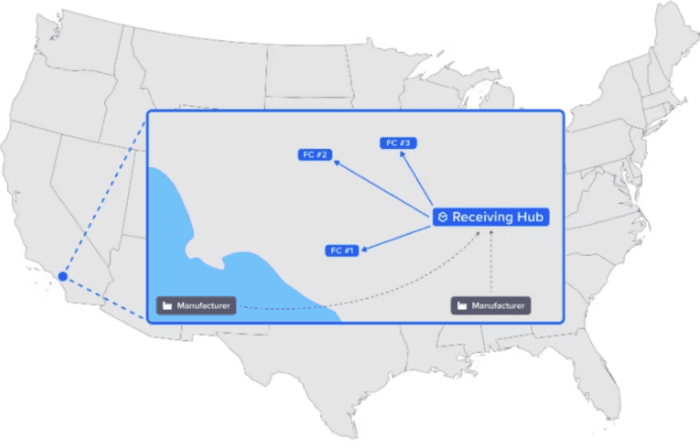Your ecommerce business is starting to grow. You’re getting more customers every day, you’ve perfected the unboxing experience, and you’re re-investing heavily in inventory.
But there’s still one thing holding you back: delivery times.
While you can ask your supplier to optimise their picking and packing process to save some time before the products are shipped out, the real challenge likely lies in your distribution model.
Experts in the ecommerce logistics industry ShipBob know that placing inventory physically closer to customers is one of the most cost-effective ways to speed up delivery. To achieve this, top-tier logistics platforms often adopt the hub and spoke distribution model.
In this article, we’ll cover what the hub and spoke distribution model is, and how the benefits of hub and spoke counteract the drawbacks of traditional distribution models.
What is the hub and spoke distribution model?
The hub and spoke distribution model is an approach to logistics management in which a business uses a centralised “hub” location to manage and distribute freight to a series of “spokes”, or secondary distribution points.

Rather than a business sending inventory directly from one point to another in a linear fashion, this model has a business bring all goods to a central location. This hub is often better equipped with smart warehousing technology to handle large amounts of incoming inventory.
From that hub, the business regionally distributes the inventory, and then delivers the final product to customers via last-mile delivery services.
The primary objective of this model is to optimise the distribution process for cheaper and faster deliveries to end customers.
The traditional fulfilment process had to go
The traditional ecommerce fulfilment process is called point-to-point. While it is often a simpler model than hub and spoke (at least in theory), it is not always more efficient – particularly in the modern ecommerce logistics landscape.
At its core, the point-to-point model is elementary: goods are dispatched from a supplier (Point A) and sent directly to the customer or retailer (Point B). On the surface, it seems like a direct, fuss-free approach.
However, with the rapid growth and globalisation of the ecommerce market, this linear model has begun to show its limitations. As businesses continue to offer broader and broader ranges of products, source from more diverse locations, and cater to a global customer base, the logistics web grows tangled.
A few pain points that have become increasingly evident in point-to-point distribution systems, including:
- Inefficiencies and delays: With every supplier having their own timelines, synchronizing them to ensure timely deliveries becomes a big hassle.
- Elevated costs: Shipping directly from multiple suppliers to customers, especially across international borders, often means dealing with high shipping costs, customs duties, and other logistical costs.
- Inventory management nightmares: Keeping track of stock levels at multiple locations and ensuring they align with demand patterns is a constant challenge. Overstocking leads to increased holding costs, while understocking results in lost sales.
- Inflexibility to market dynamics: The rigid structure of point-to-point makes adapting to sudden market changes or disruptions difficult and slow.
The limitations of a traditional distribution system simply don’t allow modern ecommerce businesses to operate as efficiently as they’re expected to. As a result, businesses and their logistics providers began developing a new strategy: the hub and spoke model.
Point-to-point vs hub and spoke distribution model
In the hub and spoke distribution model, all inventory is sent to a centralised “hub” location. While this may seem more complicated than the point-to-point model, consider the following example.

Say a business has 3 suppliers – A, B, and C in the example above (to the left). That same business has 5 fulfilment centres (D, E, F, G, and H), and uses the point-to-point inventory distribution method.
Getting inventory just one fulfilment centre (fulfilment centre D, for instance) requires only 3 distribution paths: A to D, B to D, and C to D. But as the business keeps adding fulfilment centres, the logistics of getting each supplier’s inventory to every fulfilment centre and sending inventory from one location to another to balance stock levels becomes incredibly complicated.
Using the hub and spoke method (to the right), the suppliers only ever need to send inventory to one location, and that location then sends the inventory where it needs to go.
This is why the point-to-point approach can work for brands that are still fairly small, with simple supply chains, but isn’t always right for growing, multichannel, or geographically dispersed brands. For more complex supply chains, the hub and spoke model can streamline logistics significantly.
Benefits of the hub and spoke model
The hub and spoke model represents more than just a streamlined logistical strategy—it’s a powerful tool that enables businesses to optimise their resources, improve customer satisfaction, and foster scalable growth. Here’s a deeper dive into the many benefits of the hub and spoke model.
Wider network & market
By consolidating inventory and major operations like receiving in central hubs before distributing to regional centres, businesses can extend their geographic footprint. This not only means greater access to various regional markets, but also the potential to penetrate new demographics and audiences that were previously out of reach.
This is especially useful for ecommerce businesses engaged in multichannel distribution and translates into a broader customer base and increased sales opportunities. Retail-first supplement brand Peak and Valley, for example, is always looking to add retail partnerships – and by leveraging ShipBob’s hub and spoke distribution model, it’s now easy for them to distribute inventory to retailers in a region of the US they weren’t in before.
“If we started shipping through a retail grocer with a distribution hub on the West Coast, for example, all we would have to do is distribute stock to one of ShipBob’s West Coast fulfilment centres. It’s fantastic to have that option of scaling so easily, while expanding with ShipBob.”
Nadine Joseph, Founder & CEO of Peak and Valley
Accurate & efficient order fulfilment
The hub and spoke model promotes a more organised, streamlined chain of custody for inventory and orders.
With a centralised distribution hub, businesses can maintain better oversight of their inventory during the receiving process, and incoming inventory is better accounted for.
This results in more accurate order processing, minimised picking errors, and a reduction in costly order returns or reshipments. When a system is organised, fulfilling customer orders becomes a much more seamless process.
Smart resource deployment
Resources – whether it’s inventory, labour, or transportation – are valuable assets. The hub and spoke model helps ensure that these resources are used as wisely as possible.
For instance, distributing inventory from one central hub to each regional spoke location based on demand helps a business satisfy customers without wasting inventory. If a brand sends the same slate of inventory to each regional location to cover their bases, some of it will end up collecting dust on shelves. A hub location can help direct inventory to where it’s needed most, reducing wasted stock and maximising sales.
Brands also save time and labour hours by conducting receiving operations in one hub facility, rather than in every regional location. That way, only one team must perform receiving tasks (such as counting and inspecting inventory), and the teams at spoke locations have more time to devote to fulfilment.
And when it comes to transportation, it’s much more efficient for a supplier to send inventory to a single hub location in one trip, versus making seven trips to seven regional locations. This not only cuts down on transportation costs and times, but is also more environmentally-friendly.
Shorter time-in-transit
One of the core advantages of the hub and spoke model is how it optimises distribution routes.
Depending on how accessible a regional spoke location is, it may take suppliers a long time to ship there. Hubs, on the other hand, are often intentionally located by major metropolises to make it easier for suppliers to reach, which streamlines and speeds up the transit process.
Moving goods through a central hub to a regional distribution centre also helps eliminate unnecessary detours or holding periods. This ensures that products reach customers in the shortest time possible – a critical factor in a world of 2-day fulfilment expectations.
Adjustable scalability
The hub and spoke model is a much more scalable distribution model. It allows growing businesses to scale up or down with ease, adding more spoke locations or even secondary hubs over time without overhauling the entire distribution system (or incurring massive costs).
This scalability ensures that businesses are always poised for growth without being held back by warehousing and distribution.
Cost-savings in spades
Coordinating and paying for inventory distribution across several regional locations can be expensive. As women’s wellness brand Semaine Health discovered, it’s often not only cheaper, but easier to send inventory to a single hub location and distribute it regionally from there.
“I ran the numbers to see what it would cost to ship pallets directly to different fulfilment centres, and it’s so much more expensive than sending it to one hub and letting ShipBob distribute it for us. The Inventory Placement Program’s model is much cheaper, and we don’t have to think about distribution. It’s saved us so many headaches, and now we just arrange one pickup from a manufacturer and one delivery. It’s so cheap, and so easy.”
Matt Crane, Co-Founder and Chief Science Officer at Semaine Health
ShipBob’s new hub and spoke model specializes in swift & accurate inventory distribution
Ecommerce merchants don’t just need an extensive fulfilment centre network; they also need an agile and efficient way to distribute inventory across that network.
As a global ecommerce enablement and fulfilment platform, ShipBob delivers both. We introduced the hub and spoke model across our dozens of US fulfilment centres so that brands can focus on growth while enjoying seamless receiving and distribution processes.
Strategically located to ensure seamless inventory flow, ShipBob’s hubs span across the West, Midwest, Northeast, Southwest, and Southeast regions in the US. This gives growing ecommerce brands convenient options when they’re ready to expand their geographic footprint.
These hub locations are focused on mastering the receiving process from start to finish. All a merchant has to do is send their inventory to one of our hubs, and ShipBob will receive and strategically distribute it to the regional ShipBob fulfilment centres of your choice.

.
Sending inventory to a ShipBob hub is easy. Merchants simply create and submit a warehouse receiving order (WRO) indicating what inventory is on its way to a ShipBob hub. ShipBob takes it from there, making sure to:
- Marking the inventory as “partially arrived at hub”, “arrived at hub”, or “processing”
- Fit each item with a stow tag
- Transport it to a spoke location
- Organise and stow stock at its final destination
- Complete the entire flow (from hub arrival to stowing) in a 3-day service level agreement (SLA)
Merchants can even join ShipBob’s new Inventory Placement Program to have ShipBob intelligently allocate inventory for you across our distribution network based on order history. This solution takes one of the toughest parts of inventory distribution off your plate while providing you with the real-time insights and data you need to always know exactly where your inventory is.
“One of the best parts of the Inventory Placement Program is how easy it makes inventory allocation. ShipBob manages inventory distribution for us, meaning, they choose the best locations for us, cross-dock our inventory, and see that it arrives at the ideal locations.All we have to do is send inventory to one ShipBob location through a WRO (or warehouse receiving order, which lets ShipBob track our inbound inventory, mark it as arrived, and stow it away), and they do the rest!
The program even recommends our ideal inventory split across fulfilment centres over time as our customer base shifts, based on our order data and inventory levels. It’s made things really simple and streamlined, because we can make sure that the right products and quantities are shipped without having to do the calculations ourselves. It also reduces a lot of man hours on our side, which allows us to focus on other strategic priorities.”
Mithu Kuna, Co-Founder and CEO of Baby Doppler
ShipBob’s hub and spoke system not only makes your job easier – it can make your customers happier. At the end of the day, the faster and more efficiently a logistics partner can distribute your inventory, the quicker you can get it into customers’ hands. And if you can save time, effort, and money doing it? It’s a win-win.
For more information on how ShipBob can help your business distribute inventory, click the button below to chat with an expert.
Hub and spoke distribution model FAQs
Below are answers to common questions about the hub and spoke distribution model.
How flexible is the hub and spoke model in adapting to changes in demand or supply?
The hub and spoke model offers considerable flexibility in responding to shifts in demand or supply. With a centralised hub, businesses can quickly reallocate inventory to different spokes based on their needs. This allows them to adapt to market changes without overburdening any single distribution point.
How does the hub and spoke model impact customer delivery times?
The hub and spoke model often results in quicker customer delivery times. By streamlining distribution routes through the hub, goods can be dispatched more efficiently to their regional centres and ultimately final destinations.
How does the hub and spoke model differ from a point-to-point distribution system?
The primary difference lies in the distribution structure. In a point-to-point system, goods are shipped directly from one location to another, creating a web of individual routes. On the other hand, the hub and spoke model centralises the distribution process by first sending goods to a main hub, which then redistributes them to various spokes or end destinations.
Are there any benefits to using a point-to-point model over hub and spoke distribution?
The point-to-point model can have advantages in certain scenarios. For businesses with a limited number of distribution points or for specialized shipments that require direct routes, point-to-point can offer simpler logistics and potentially faster direct shipments without the need for intermediate sorting or handling at a central hub.



